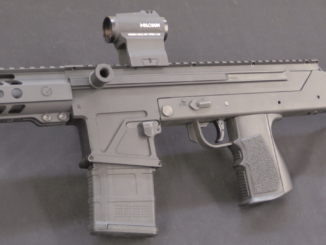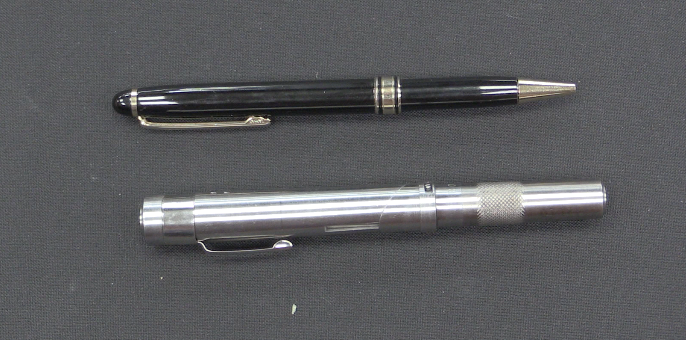As the Model 1873 began to show its age, Winchester wanted a new rifle to take its place in the company catalog. Scaling down the Model 1886 to the pistol cartridges of the 1873 seemed like a fine option, and Winchester executives approached John Browning, offering him $10,000 if he could produce such a gun within 3 months, or $15,000 if he could do the job in two months. Browning’s response was to say that he would take $20,000 and have the rifle in company hands within 30 days – or else he would give it to them for free.
The $20,000 that Winchester paid him for the new rifle was well worth it, as the 1892 would become the best selling Winchester rifle to that date, selling more than a million guns by the 1930s. It used the stronger and more cost effective locking system of the 1886, while being chambered for the same cartridges as the 1873 – the .44 WCF (.44-40), .38 WCF (.38-40), and .32 WCF (.32-20), as well as a few new cartridges added over time.




Did you mean ‘scaling down the 1886’?
Browning, you magnificent b*****d, I saw your work!
“As the Model 1873 began to show its age, Winchester wanted a new rifle to take its place in the company catalog.”
How Winchester did advertise 1892 gun? What they promised it will give over older 1873?
“rifle in company hands within 30 days – or else he would give it to them for free.”
Does this suggest that Browning earlier was thinking about such gun? Or it was totally possible to do that starting from zero?
I would guess Browning considered scaling down an existing design of his own an almost trivial task. The fact that he offered to do it for free if it wasn’t ready in a month suggests that he probably could have done it significantly faster, if he had really tried. The fact that a prototype was ready in two weeks supports that notion.
Similarly, the first Maxim gun prototypes were readied pretty quickly, considering that they had been constructed in Maxim’s backyard (and Maxim had to forge some of the tooling along with the guns). One would probably have expected the machineguns to take a minimum of 15 YEARS to get from drawing board to the prototype stages with little more than ballistic/engineering stress data acquired from the local library/book store, privately purchased rifle barrels, machined bar stock, and a requirement for custom-made (backyard forge made) tooling for custom-made forgings and/or castings (I can’t remember which metal components came first). Most English intellectuals and businessmen laughed at Hiram S. Maxim, saying that he was just a bragging Yankee electrician with no possible way to get military contracts for what appeared to be a ridiculously complicated bundle of tubes and cloth belt on an overweight camera tripod. Maxim’s “Forerunner” prototype quickly riddled the insults with bullet holes! After the demonstration, the only problem was simplifying the design for mass production and so that one could maintain the machinegun without requiring specialized tools.
Did I mess up? SAY SOMETHING!!
“scaling down an existing design of his own an almost trivial”
Scaling down design, so it would work is quite easy, but it does not automatically mean that obtained weapon, will be success, for example W+F MP 41: http://modernfirearms.net/smg/switch/w-f-lmg-pist-41-44-e.html
was dwarf version of Lmg 25. MP 41 worked (that is loaded cartridges, fired bullets and ejected cases), but it was heavier and more expensive that other sub-machine guns of its era.
I’ll bet he already had at least one prototype finished and ready to go before he and his brother left on that trip to see Winchester.
It was said by people who knew John B. that he sometimes referred to his business trip(s) back east to meet with Winchester as ” Raids on Hartford “.
Pretty funny, actually.
“$10,000 if he could produce such a gun within 3 months, or $15,000 if he could do the job in two months”
Why Winchester was so impatient to get new rifle? Was it answer to Marlin Model 1889 Safety Repeating Rifle(did it get popularity when introduced?)?
http://www.marlinforum.com/Meet-the-50-000-Dollar-Marlin-Model-1889-Lever-Action-Rifle-Marlin-Forum.html
20,000 in 1890, adjusted for inflation is about 500,000. Browning wasn’t hurting for money.
“20,000 in 1890, adjusted for inflation is about 500,000. Browning wasn’t hurting for money.”
As it was no earlier than 1879 and no later than 1933, it was true that:
1 ounce of gold = $20.67;
which mean you can exchange $20000 for about 968 ounces. This site:
http://goldprice.org/gold-price.html
show gold price to be roughly in 1250-1275 (per ounce) area, which assuming lower value (1250) would give $1210000.
Daweo, you slipped a digit. 968 x 1250 = 1.2 million.
No, he didn’t. $1210000 = $1,210,000 ≈ $1.2 Million 😀
My bad eyes strike again.
“you slipped a digit”
I intentionally avoid naming big numbers, as there exist U.S. style and European style, so first understand Billion as 1000000000 (1 and nine nulls), when second as 1000000000000 (1 and twelve nulls).
To make it clear, I meant 1210000 or in zeroless fashion 1.21e6
Daweo, I understand. Using commas in long strings of numbers helps with clarity, at least in the US. I simply miscounted zeroes.
Using gold as a metric is probably the correct way to look at inflation, but I have my doubts about any currencies returning to a gold standard. Here in the US, there has been an incentive (since the 1970s or 1980s) to under report “official” inflation rates because some government disbursements are tied to inflation. Using “official” rates becomes unreliable. JMB was doing pretty well in either case.
Having known almost nothing about Winchester lever action rifles before Iain started this series, it strikes me that the Winchester company had started with a law suit, which they won; then chanced on Browning, and realised his worth. I bet Bennett would not have travelled to Browning if his company had not already made a freight train full of money from the patents they’d already bought off him.
In that context, and the fact these were two individuals in a room with not even a thought for lawyers, then: $10,000 in three months or $15,000 in two… OK! If it’s on my desk in Connecticut this time next month I’ll give you $20,000 John.
That kind of personal relationship will explain the deal, even if my version is not what happened. Winchester had much money. They could have got the Browning patent redesigned for a lot less; but who knew if it would be as good as Browning’s redesign of his own version? And who knew how angry John Browning would be with Winchester the next time he had worked out a brilliant idea?
Glyn, there was a TV series about 2000 called “Tales of the Gun”. There were episodes about Guns of Browning, Smith and Wesson, and Winchester that are relevant to this series. They are easily found on the interwebs, just saying.
“They could have got the Browning patent redesigned for a lot less; but who knew if it would be as good as Browning’s redesign of his own version?”
In fact, Winchester rescaled Browning’s work, but it was another design and later – namely Winchester Model 42, see photo here:
https://winchestercollector.org/models/model-42-shotguns/
which was more-or-less scaled down Winchester Model 1912, for .410.
It was produced from 1933 to 1963, with around 160000 examples made, so it seems be reasonable successful.
If Winchester M1973 was the gun that “won the West” historically, the M1892 was the gun that won it on the silver screen, carried by John Wayne and others.
Ghetto edit: M1873, not M1973
The 1892 clearly had a time machine feature built in as in the movies it went back in time a lot.
“M1892 was the gun that won it on the silver screen”
Most obvious explanation is that it was much easier to obtain for movie producers, aswell close enough (to 1873) for most spectators, but I think, basing on our previous topics, that 1892 might be prefer over 1873, because for that second overall-length of cartridge was critical for proper working – movie makers used so called 5-in-1 blanks: http://www.oldammo.com/april10.htm for which tolerance for overall length might be more than live .44-40 (or .38-40), so it would be possibly that 1873 would fail if loaded with it.
For those who do not familiar with lever action rifles; Lever should be actuated by the underweb of cocking hand, not by the knuckle…Otherwise, especially by follow up shots, pain, even hurt might be got.
Like this? https://www.youtube.com/watch?v=Wb4Q3jtyapc
No!… Should never be attempted by any of loaded lever guns… Besides this kind of Juggler acts need some changes and adds to the firearm action to keep the round inside through whirling. What I wanted to describe, is the usual lever cocking during shooting. Some immediately learn using the underside of hand after getting the pain at the knuckles striking against the lever underbar and some never learn in whole life.
A friend of mine had a 92 rifle back in the sixties in .32/20. A sweet shooter.
John Wayne and Chuck Conner used 1892 so they could twirl cock it with large lever loop without hitting themselves in the head. It could also be done with 1894, but this model was not sufficiently “Old West” looking enough.
I wonder if the rush was due to Winchester wanting to have something “new” at the 1893 Columbian Exposition in Chicago. There is an incredible engraved 1892 that was on display at the Exposition.